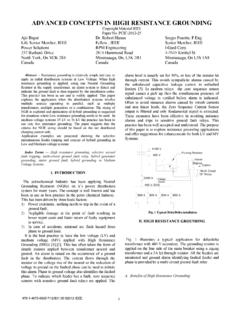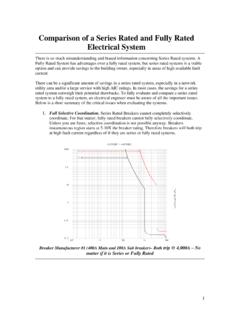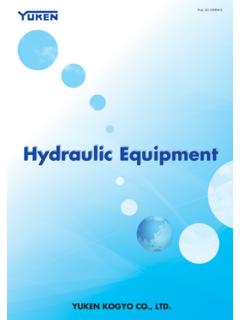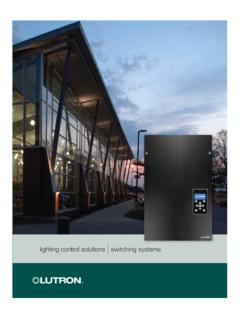Transcription of High Resistance Grounding—Avoiding …
1 1146 IEEE TRANSACTIONS ON INDUSTRY APPLICATIONS, VOL. 45, NO. 3, MAY/JUNE 2009. high Resistance grounding avoiding unnecessary pitfalls David Murray, Senior Member, IEEE, John Dickin, Senior Member, IEEE, Robert A. Hanna, Fellow, IEEE, and Tom Morin Abstract The high Resistance grounding (HRG) of 480 4160-V multiple simultaneous motor insulation failures [2], [3]. industrial power systems increases service continuity, enhances These voltage excursions could be mitigated by the solid personnel safety, and reduces equipment damage when a ground grounding of the neutral. fault occurs. HRG allows maintenance personnel to quickly and safely locate a ground fault while avoiding unscheduled downtime. 2) For many industrial plants, it was deemed less risky to An abundance of literature has been published on HRG practices trip a faulted circuit using the high -ground-fault current since the mid-1970s.
2 Recent years have seen increased application of a solidly grounded system than to maintain service and misapplication of transient voltage surge suppressors and continuity with an ungrounded system . uninterruptible power supplies in HRG power systems. These 3) Solidly grounded 277/480-V systems accommodated the misapplications and their solutions are discussed. Additionally, en- gineering oversights in the design of HRG systems are addressed, new 277-V fluorescent ballasts, which provided more as well as operations and maintenance issues associated with an economical lighting [4]. HRG system . However, the solid grounding of 480- and 600-V systems created a new challenge low-level arcing ground faults and Index Terms high Resistance grounding (HRG), transient voltage surge suppressor (TVSS), uninterruptible power supply their consequent damage [5].
3 HRG has proven to provide (UPS). excellent protection from a low-level arcing ground fault. The HRG system is popular primarily because of the service I. I NTRODUCTION continuity it provides during a ground fault. An added benefit is the enhanced electrical safety from arc flash on a ground fault. T HE high Resistance grounding (HRG) of low-voltage power distribution systems in North America became popular in the early 1970s for continuous-process industries. Numerous IEEE papers have been published since 1975 on the benefits and proper application of HRG for continuous- process industries [1], [3], [4], [6] [12]. More recent papers At that time, the National Electrical Code (NEC) and Canadian have focused on the application of adjustable speed drives Electrical Code were amended to require the main overcurrent (ASDs) [13] [15] and uninterruptible power supplies (UPSs).
4 Protective device to automatically trip on ground fault on most [16] on an HRG system . Nonetheless, the authors have encoun- 480- and 600-V solidly grounded systems. The purpose of the tered application pitfalls in HRG that are not fully addressed code change was to minimize the occurrence of equipment in the literature. Cases described in this paper include the burndowns due to arcing ground faults [1]. Prior to the 1940s, following: industrial power systems were ungrounded because the loads 1) transient voltage surge suppressors (TVSSs) that ruptured were three-wire and service continuity could be maintained when improperly applied on an HRG system ;. during a ground fault. During the 1940s, ungrounded low- 2) a three-phase isolated redundant UPS that failed and voltage systems gave way to solidly grounded systems for the subsequently lost the critical load when improperly con- following reasons.
5 Nected to an HRG source;. 1) It was discovered that intermittent arcing ground faults 3) an incompatible grounding method between the bypass on ungrounded systems could experience L-G voltage input and inverter output of a three-phase UPS that ex- excursions up to six times above normal, leading to posed the critical load to risk during ground faults;. 4) the need for four-pole breakers on the output of par- Paper PID-08-02, presented at the 2007 IEEE Petroleum and Chemical allel three-phase UPS modules that are high Resistance Industry Technical Conference, Calgary, AB, Canada, September 17 19, grounded;. and approved for publication in the IEEE TRANSACTIONS ON INDUSTRY. APPLICATIONS by the Petroleum and Chemical Industry Committee of 5) a comparison of present HRG practices between parallel the IEEE Industry Applications Society.
6 Manuscript submitted for review UPS modules and generators. December 15, 2007 and released for publication November 12, 2008. Current version published May 20, 2009. Furthermore, discussed are design shortcomings in ground- D. Murray is with Schneider Electric, Toronto, ON M4B 1Y2, Canada fault protection and alarm systems that are still prevalent in (e-mail: modern HRG installations. The lack of a clear and logical alarm J. Dickin is with Dickin Engineering Inc., Red Deer, AB T4P 1T3, Canada (e-mail: system fails to indicate the seriousness of leaving a ground R. A. Hanna is with RPM Engineering Ltd., Mississauga, ON L5K 2R1, fault on the system and provides poor navigation to the location Canada (e-mail: of the ground fault. Furthermore, unclear operating procedures T.)))
7 Morin is with Petro-Canada Oil & Gas, Calgary, AB T2P 3E3, Canada (e-mail: leave confusion and delays in the appropriate actions when a Digital Object Identifier ground fault occurs. 0093-9994/$ 2009 IEEE. Authorized licensed use limited to: Robert Hanna. Downloaded on June 12, 2009 at 20:38 from IEEE Xplore. Restrictions apply. MURRAY et al.: high Resistance grounding avoiding unnecessary pitfalls 1147. Fig. 1. TVSS for solidly grounded system . TABLE I. Fig. 2. TVSS for high Resistance grounded system . TYPICAL MCOV RATINGS FOR THREE-PHASE FOUR-WIRE SYSTEMS. TABLE II. TYPICAL MCOV RATINGS FOR THREE-PHASE. THREE-WIRE HRG SYSTEMS. II. A PPLICATION P ITFALLS TO A VOID. ratings, of MOVs in TVSS units designed for a three-phase A. TVSSs three-wire HRG system .)
8 In the late 1990s, a TVSS ruptured in a new 600-V switch- In North America, 480- and 600-V HRG systems are three- board at a data center in southern Ontario, Canada. The 600-V wire. The neutral is not distributed because it becomes ener- distribution system was high Resistance grounded through a gized during a ground fault. Hence, there is no need for L-N. 5-A 347-V 69- neutral grounding resistor (NGR). Investiga- or N-G protection modes on a TVSS used on a 480- or 600-V. tion revealed that the TVSS, rated for a three-phase four-wire HRG system . 347/600-V wye system , failed during a ground fault when the HRG systems do not exhibit the six times voltage excursion metal oxide varistors (MOVs) connected from line to ground above ground that could be present in ungrounded systems (L-G) were exposed to excessive continuous voltage on the two during intermittent arcing ground faults.
9 The let-thru current unfaulted phases during the ground fault. The applied voltage of an NGR is always chosen to be higher than the capacitive exceeded the rated maximum continuous operating voltage system charging current. Hence, the continuous L-G voltage (MCOV) of the MOVs. during a ground fault will not exceed 600 V on a 600-V system The TVSS was designed for use on a solidly grounded or 480 V on a 480-V system . system . It had been misapplied on the HRG system . Fig. 1 The 2005 NEC, in section (3), calls for the MCOV of shows the typical connections, and Table I shows the typical a TVSS to exceed the maximum continuous phase-to-ground ratings, of MOVs in TVSS units designed for three-phase four- voltage available at the point of application.
10 Section (2). wire solidly grounded systems. line to line (L-L) mode MOVs specifies that a TVSS used on a Resistance grounded system be are shown dotted because they are often omitted. Line-to-line listed for use on this type of system . protection is effectively provided though the line to neutral It is anticipated that UL 1449, TVSSs, will also have to (L-N) and L-G MOVs. Between any two phases, there are two be amended to add a listing for use on Resistance grounded L-N mode MOVs in series and two L-G mode MOVs in series. systems. When published, it is expected that the UL listing will An MCOV of 420 V is sufficient for MOVs connected L-G remove some of the ambiguity in applying a TVSS to an HRG. on a solidly grounded 347/600-V system . Continuous L-G system .





